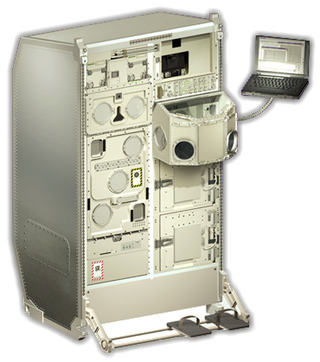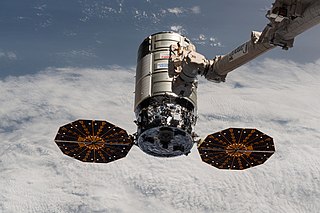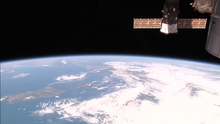
Spacelab was a reusable laboratory developed by European Space Agency (ESA) and used on certain spaceflights flown by the Space Shuttle. The laboratory comprised multiple components, including a pressurized module, an unpressurized carrier, and other related hardware housed in the Shuttle's cargo bay. The components were arranged in various configurations to meet the needs of each spaceflight.

Columbus is a science laboratory that is part of the International Space Station (ISS) and is the largest single contribution to the ISS made by the European Space Agency (ESA).

The Automated Transfer Vehicle, originally Ariane Transfer Vehicle or ATV, was an expendable cargo spacecraft developed by the European Space Agency (ESA), used for space cargo transport in 2008–2015. The ATV design was launched to orbit five times, exclusively by the Ariane 5 heavy-lift launch vehicle. It effectively was a larger European counterpart to the Russian Progress cargo spacecraft for carrying upmass to a single destination—the International Space Station (ISS)—but with three times the capacity.

A Multi-Purpose Logistics Module (MPLM) is a large pressurized container that was used on Space Shuttle missions to transfer cargo to and from the International Space Station (ISS). Two MPLMs made a dozen trips in the Shuttle cargo bay and initially berthed to the Unity and later the Harmony module on the ISS. Once attached, supplies were offloaded, and finished experiments and waste were reloaded. The MPLM was then transferred back into the Shuttle’s cargo bay for return to Earth. Three modules were built by Alenia Aeronautica for the Italian Space Agency (ASI). They were named Leonardo, Raffaello, and Donatello.

Uncrewed spaceflights to the International Space Station (ISS) are made primarily to deliver cargo, however several Russian modules have also docked to the outpost following uncrewed launches. Resupply missions typically use the Russian Progress spacecraft, European Automated Transfer Vehicles, Japanese Kounotori vehicles, and the American Dragon and Cygnus spacecraft. The primary docking system for Progress spacecraft is the automated Kurs system, with the manual TORU system as a backup. ATVs also use Kurs, however they are not equipped with TORU. The other spacecraft — the Japanese HTV, the SpaceX Dragon and the Northrop Grumman Cygnus — rendezvous with the station before being grappled using Canadarm2 and berthed at the nadir port of the Harmony or Unity module for one to two months. Progress, Cygnus and ATV can remain docked for up to six months. Under CRS phase 2, Cargo Dragon docks autonomously at IDA-2 or 3 as the case may be. As of November 2024, Progress spacecraft have flown most of the uncrewed missions to the ISS.
The Extreme Universe Space Observatory onboard Japanese Experiment Module (JEM-EUSO) is the first space mission concept devoted to the investigation of cosmic rays and neutrinos of extreme energy (E > 5×1019 eV). Using the Earth's atmosphere as a giant detector, the detection is performed by looking at the streak of fluorescence produced when such a particle interacts with the Earth's atmosphere.

Akihiko Hoshide is a Japanese engineer, JAXA astronaut, and former commander of the International Space Station. On August 30, 2012, Hoshide became the third Japanese astronaut to walk in space.

Biolab is a single-rack multi-user science payload designed for use in the Columbus laboratory of the International Space Station. Biolab supports biological research on small plants, small invertebrates, microorganisms, animal cells, and tissue cultures. It includes an incubator equipped with centrifuges in which the preceding experimental subjects can be subjected to controlled levels of accelerations.

The Columbus Control Centre also known by its radio callsign, Mission Control Munich, is the mission control centre which is used to control the Columbus research laboratory, which is part of the International Space Station (ISS). The control centre is located at the German Aerospace Center (DLR) facility in Oberpfaffenhofen near Munich, Germany. The centre is operated by the DLR, under contract from the European Space Agency (ESA).

The European Drawer Rack (EDR) is a single, six-post International Standard Payload Rack (ISPR) with seven Experiment Modules (EMs), each of which has separate access to power and cooling. A video management unit sends streaming video, images, and science data to Earth via the Columbus module's high-rate data link and can temporarily store 72 GB of video. The experiments are largely autonomous to minimize data transfer requirements, though the EDR can be operated remotely via telescience or in real time by the crew via a dedicated laptop. The EDR has two different types of EMs: the standard International Space Station locker and the standard eight panel unit International Subrack Interface Standard (ISIS) drawer.

The Columbus External Payload Facility (Columbus-EPF) is a component of the Columbus module on the International Space Station. It consists of two identical L-shaped consoles attached to the starboard cone of Columbus in the zenith (top) and nadir (bottom) positions, each supporting two platforms for external payloads or payload facilities. Four external payloads can be operated at the same time.

The European contribution to the International Space Station comes from 10 members of the European Space Agency (ESA) and amounts to an 8% share in the programme. It consists of a number of modules in the US Orbital Segment, ATV supply ships, launchers, software and €8 billion.

SpaceX CRS-4, also known as SpX-4, was a Commercial Resupply Service mission to the International Space Station (ISS), contracted to NASA, which was launched on 21 September 2014 and arrived at the space station on 23 September 2014. It was the sixth flight for SpaceX's uncrewed Dragon cargo spacecraft, and the fourth SpaceX operational mission contracted to NASA under a Commercial Resupply Services contract. The mission brought equipment and supplies to the space station, including the first 3D printer to be tested in space, a device to measure wind speed on Earth, and small satellites to be launched from the station. It also brought 20 mice for long-term research aboard the ISS.

Nanoracks LLC is an American private in-space services company which builds space hardware and in-space repurposing tools. The company also facilitates experiments and launches of CubeSats to Low Earth Orbit.

SpaceX CRS-20, also known as SpX-20, was a Commercial Resupply Services mission to the International Space Station (ISS) launched on 7 March 2020. The mission was contracted by NASA and flown by SpaceX. It was the final flight of Dragon 1 and concluded the NASA Commercial Resupply Services (CRS-1) contract extension.

NG-13, previously known as OA-13, was the fourteenth flight of the Northrop Grumman robotic resupply spacecraft Cygnus and its thirteenth flight to the International Space Station (ISS) under the Commercial Resupply Services (CRS-1) contract with NASA. The mission launched on 15 February 2020 at 20:21:01 UTC after nearly a week of delays. This is the second launch of Cygnus under the CRS-2 contract.

NG-14, previously known as OA-14, was the fifteenth flight of the Northrop Grumman robotic resupply spacecraft Cygnus and its fourteenth flight to the International Space Station under the Commercial Resupply Services (CRS-1) contract with NASA. The mission was launched on 3 October 2020, at 01:16:14 UTC.

SpaceX CRS-24, also known as SpX-24, was a Commercial Resupply Service mission to the International Space Station launched on 21 December 2021, at 10:07:08 UTC. The mission is contracted by NASA and is flown by SpaceX using a Cargo Dragon. This is the fourth flight for SpaceX under NASA's CRS Phase 2 contract awarded in January 2016.
The German space programme is the set of projects funded by the government of Germany for the exploration and use of outer space. The space programme is run by the German Aerospace Center, who conduct research, plan, and implement the programme on behalf of the German federal government.

SpaceX CRS-26, also known as SpX-26, was a Commercial Resupply Service mission to the International Space Station (ISS) launched on 26 November 2022. The mission was contracted by NASA and flown by SpaceX using a Cargo Dragon. This was the sixth flight for SpaceX under NASA's CRS Phase 2 contract awarded in January 2016.




















